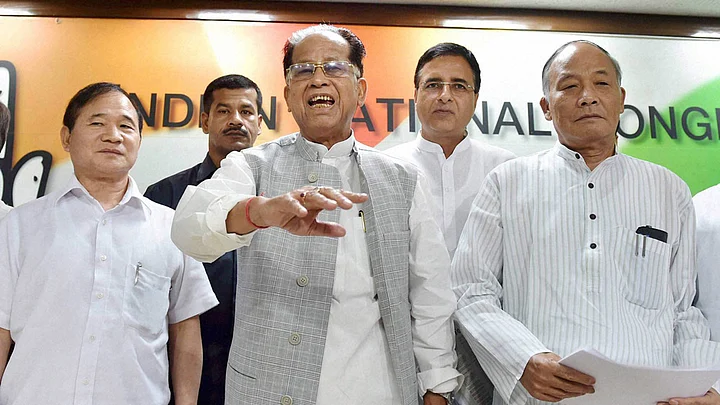Playing Second Fiddle?
- After the ceasefire agreement with the NSCN(K), rift between the two Naga outfits widened further
- Jamir, the then chief minister was widely believed to actively encourage and support the NSCN(K) to checkmate the NSCN(IM)
- Jamir and the Centre (both UPA and NDA) were not on the same page as far as dealing with the Naga insurgency was concerned
Establishing a modicum of peace in Nagaland and in the Naga-inhabited areas, is important for the political negotiations to proceed smoothly. The first four years of talks with the NSCN(IM) centered round setting up an effective ceasefire monitoring mechanism to maintain peace.
However, even though peace prevailed between the security forces and NSCN(IM), with attacks on civilians by the rebel outfit, tranquility in the area was often disturbed because of violent armed clashes between the two Naga factions. After the ceasefire agreement with the NSCN(K), a new problem arose, namely the reluctance of the rival factions in moving to designated camps unless the other faction moved first.
Extortions by both groups continued, though they were not as rampant as in the beginning. This is a law and order problem and success in controlling it depends a great deal on the attitude of the Nagaland government towards the insurgent groups in general and to the rival factions in particular. At the time of signing of the ceasefire with the NSCN(IM), in 1997, the then Chief Minister was S C Jamir, a bitter critic of Thuingaleng Muivah and openly opposed the ceasefire and talks with the insurgent group.
Jamir’s Support for NSCN(K)
With two strong rival factions in the state, a CM’s strategy could be to maintain equidistance with both groups, or be equally friendly, or to support one group against the other, depending to a great extent on tribal loyalties. It was widely believed that Jamir was actively encouraging and supporting the NSCN(K) to checkmate the NSCN(IM). Jamir continued as CM till 2003 and the NSCN(IM)’s constant refrain was that the NSCN(K) was being encouraged by the CM to attack their cadres and camps, and that unless this stopped, the NSCN(IM) would withdraw from the ceasefire and the talks .
The rivalry between Jamir and the NSCN(IM) was so strong that when a militant group attacked his motorcade with heavy weapons, (miraculously Jamir escaped unhurt), many believed that it was carried out by the NSCN(IM). A minority of senior officials in the central government, believed that S S Khaplang should be given a free hand so that Muivah (with whom negotiations were on to find a lasting solution) is kept in check. It was a tough balancing act.
When Jamir was succeeded by Neiphiu Rio as CM, the situation reversed, as by and large people believed that he was a supporter of the NSCN(IM), though he described his stand as equidistant. Thus whether the extortions by the militant groups were controlled or not depended very much on the sympathies the chief minister had with a particular group, and what support the state government gave to the security forces.
Extreme Demands
The inter-factional rivalry also led each group to make more radical and extreme political demands from the government, in a game of oneupmanship. Since serious negotiations were at that time only with the NSCN(IM) (which submitted a proposal for such discussions in September 2001), the Khaplang faction accused Muivah of being an Indian agent and alleged a sell-out. The rival groups would try their best to torpedo any deal Muivah may strike with the government.
The Naga civil society groups and the church have been trying for a rapprochement between the rival factions but only with marginal success. Often suggestions are made that all the Naga factions should be involved in talks. As of now, the NSCN(K) has split into three groups, and expecting all the four rival outfits to come together and negotiate a common agreement is practically impossible.
The right course of action would be to work out an agreement with the NSCN(IM), and before inking it, other factions may be invited to join in. If they choose not to, they need to be dealt with differently. Khaplang has withdrawn from the ceasefire and signed a ceasefire with the Myanmar army. He is bound to create road blocks to the agreement with Muivah and in its implementation on the ground.
Nagaland Government’s Role
A question is sometimes raised, on the role of the state government in the peace negotiations. A reference has already been made about Jamir’s total opposition to talks with the NSCN(IM). There would have been no talks if the Nagaland government was a formal party to the negotiations. I am not implying that Jamir was against solving the Naga problem. I think he believed that there is no Naga political problem as such.
Jamir and the Centre (both UPA and NDA) were not on the same page as far as dealing with the Naga insurgency and political problem was concerned. Besides, the powerful civil society organisations in Nagaland held the view that while a state government has been elected to run the administration, the Naga political issue can only be discussed by the Centre with the “National Workers” (as the insurgent organisations and their leaders are called).
While the Centre did consult the state government as and when required, the Nagaland government was also content in playing a limited role. But as the details of the accord are being worked out, the state government(s) would have to be taken on board.
(A former Union Home Secretary, K Padmanabhaiah was the Centre’s interlocutor for the Naga peace talks between 1999 and 2009)
(This is the second of a three-part series by the author. Read the first part here.)
